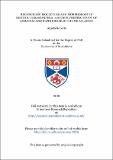Files in this item
Reconciling molecules and morphology in benthic foraminifera : a morphometric study of Ammonia and Elphidiidae in the NE Atlantic
Item metadata
| dc.contributor.advisor | Austin, W. E. N. (William E. N.) | |
| dc.contributor.advisor | Darling, Kate | |
| dc.contributor.author | Roberts, Angela | |
| dc.coverage.spatial | xviii, 315 p. | en_US |
| dc.date.accessioned | 2019-06-12T14:52:54Z | |
| dc.date.available | 2019-06-12T14:52:54Z | |
| dc.date.issued | 2016-06-22 | |
| dc.identifier.uri | https://hdl.handle.net/10023/17878 | |
| dc.description | Electronic version excludes material for which permission has not been granted by the rights holder | en |
| dc.description.abstract | A robust and consistent taxonomy underpins the use of fossil material in palaeoenvironmental research and long-term assessments of biodiversity. However, the successful identification of benthic foraminiferal species is often challenged by enigmatic morphological species boundaries, nomenclatural uncertainty and the recent advent of molecular techniques and the identification of cryptic species. This thesis sought to reconcile molecules and morphology in two scientifically important yet taxonomically challenging groups of benthic foraminifera, the genus Ammonia and the family Elphidiidae, in samples obtained widely across the NE Atlantic shelf seas. Through the production of detailed quantitative morphometric analysis of over 750 genetically sequenced specimens, coupled with assessments of their biogeographical distributions, this thesis provides the most comprehensive re-evaluation of these taxa conducted to date. The integration of these new lines of taxonomic evidence has refined interspecific boundaries, clarified key diagnostic morphological features and has unveiled the presence of a number of enigmatic species boundaries (particularly within the genus Ammonia). The results highlight that classical morphospecies concepts may not always accurately reflect the genetic diversity currently found within this region, which could have important repercussions for applied taxonomic investigations. The extensive sampling across the NE Atlantic has also enabled one of the first re-evaluations of intraspecific morphological variability, revealing that many specimens taken from distinct sampling localities can be morphologically delineated. In a first step to addressing temporal dynamics of previously unrecognised cryptic species, a time series study was conducted in the NW Scottish shelf seas, which unveiled subtle seasonal partitioning between two sympatric species of Ammonia. Finally, a new taxonomic framework was developed which bridges the current discontinuity between molecular and morphological lines of evidence. This new framework, applied to Elphidium williamsoni (Haynes, 1973), provides the first clear link between morphologically characterised type material and a unique genotype. | en_US |
| dc.language.iso | en | en_US |
| dc.publisher | University of St Andrews | |
| dc.subject | Morphometrics | en_US |
| dc.subject | Integrated taxonomy | en_US |
| dc.subject | Biodiversity | en_US |
| dc.subject | Benthic foraminifera | en_US |
| dc.subject.lcc | QL368.F6R7 | |
| dc.subject.lcsh | Foraminifera--Morphology | en |
| dc.subject.lcsh | Foraminifera--North Atlantic Ocean | en |
| dc.title | Reconciling molecules and morphology in benthic foraminifera : a morphometric study of Ammonia and Elphidiidae in the NE Atlantic | en_US |
| dc.type | Thesis | en_US |
| dc.contributor.sponsor | Natural Environment Research Council (NERC) | en_US |
| dc.type.qualificationlevel | Doctoral | en_US |
| dc.type.qualificationname | PhD Doctor of Philosophy | en_US |
| dc.publisher.institution | The University of St Andrews | en_US |
This item appears in the following Collection(s)
Items in the St Andrews Research Repository are protected by copyright, with all rights reserved, unless otherwise indicated.

